
Pocket LOOX was a series of Pocket PC-based personal digital assistants (PDAs) and navigation systems developed by Fujitsu Siemens. It was discontinued in 2007. [1]

Pocket LOOX was a series of Pocket PC-based personal digital assistants (PDAs) and navigation systems developed by Fujitsu Siemens. It was discontinued in 2007. [1]
Pocket LOOX 600 was the first PDA by Fujitsu Siemens [2] and HTC, released in 2002. It had a built-in Bluetooth module and two expansion slots, SD/MMC and CF. Fujitsu Siemens later released a GPRS expansion module that provides mobile phone functionality.
| Model | RAM (MiB) | ROM (MiB) | Slots | CPU | MHz | OS | Screen resolution | WiFi | Bluetooth | IrDA | More |
|---|---|---|---|---|---|---|---|---|---|---|---|
| Pocket LOOX 400 series | |||||||||||
| Pocket LOOX 410 [3] | 64 | 32 | 1SD | PXA255 | 300 | WM 2003 | 320×240 | No | Yes | Yes | |
| Pocket LOOX 420 [4] | 64 | 32 | 1SD | PXA255 | 400 | WM 2003 | 320×240 | 802.11b | Yes | Yes | |
| Pocket LOOX 600 series | |||||||||||
| Pocket LOOX 600 [5] | 64 | 32 | 1SD 1CF | PXA250 | 400 | PPC 2002, WM 2003* | 320×240 | No | Yes | Yes | Optional GPRS module |
| Pocket LOOX 610 BT [6] | 64 | 64 | 1SD 1CF | PXA255 | 400 | WM 2003 | 320×240 | No | Yes, 1.11 | Yes | |
| Pocket LOOX 610 BT/WLAN [6] | 64 | 64 | 1SD 1CF | PXA255 | 400 | WM 2003 | 320×240 | 802.11b | Yes, 1.11 | Yes | |
| Pocket LOOX 700 series [7] | |||||||||||
| Pocket LOOX 710 | 64 | 64 | 1SD 1CF | PXA272 | 416 | WM 2003 SE | 320×240 | 802.11b | Yes, 1.2 | Yes | |
| Pocket LOOX 718 | 128 | 64 | 1SD 1CF | PXA272 | 520 | WM 2003 SE | 640×480 | 802.11b | Yes, 1.2 | Yes | |
| Pocket LOOX 720 | 128 | 64 | 1SD 1CF | PXA272 | 520 | WM 2003 SE | 640×480 | 802.11b | Yes, 1.2 | Yes | 1.3 MP camera with flash |
| Pocket LOOX C series | |||||||||||
| Pocket LOOX C550 [8] | 64 | 64 | 1SD | PXA270 | 520 | WM 5.0 Premium | 640×480 | 802.11b/g | Yes, 1.2 | Yes | |
| Pocket LOOX N series [9] | |||||||||||
| Pocket LOOX N100 | 0–4 M | 64 | 1 miniSD | SAMSUNG SC32442 | 300 | WM 5.0 Premium | 320×240 | No | No | No | GPS, no PDA navigation only |
| Pocket LOOX N500 | 64 | 64 | 1 SD | PXA270 | 312 | WM 5.0 Premium | 320×240 | No | No | Yes | GPS |
| Pocket LOOX N520 | 64 | 128 | 1 SD | PXA270 | 312 | WM 5.0 Premium | 320×240 | 802.11b/g | No | Yes | GPS |
| Pocket LOOX N560 | 64 | 128 | 1 SD | PXA270 | 624 | WM 5.0 Premium | 640×480 | 802.11b/g | Yes, 1.2 | Yes | GPS |
| Pocket LOOX T series [10] | |||||||||||
| Pocket LOOX T810 | 64 | 128 | 1 SD | PXA270 | 416 | WM 5.0 Phone Edition | 240×240 | 802.11b/g | Yes, 2.0 | No | GSM/UMTS Module, GPS |
| Pocket LOOX T830 | 64 | 128 | 1 SD | PXA270 | 416 | WM 5.0 Phone Edition | 240×240 | 802.11b/g | Yes, 2.0 | No | GSM/UMTS Module, GPS, VGA camera for video calls, 2 MP camera with autofocus |
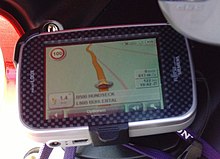
Pocket LOOX navigation systems were powered by Navigon MobileNavigator|6s. [12] There were 9 maps supplied with device, covering 37 European countries. Main difference between N100 and N110 is that N100 did not have any built-in user accessible memory, but came with 1 GB Mini SD card. N110 on the other hand had 2 GB built-in memory and a free Mini SD expansion slot.
| Model | RAM (MiB) | ROM | Slots | CPU | OS | Screen resolution |
|---|---|---|---|---|---|---|
| Pocket LOOX N100 | 64 | N/A | 1 Mini SD | Samsung 300 MHz | Windows CE 5.0 | 320×240 |
| Pocket LOOX N110 | 64 | 2GB | 1 Mini SD | Samsung 300 MHz | Windows CE 5.0 | 320×240 |
It is possible to run Linux on Pocket LOOX 600. [13] The latest supported version of Linux kernel is 2.4.19. Linux is loaded from a CF card, allowing a return to PocketPC 2002. But during restart, all contents of RAM are erased. To prevent data loss, users should back-up RAM before restarting Linux.
Work is being done to port Android to Pocket Loox 720. [14] A port of Android 2.2 is running on the 720. It is possible to boot from either CF or SD cards; as mentioned above, a backup of all data is highly recommended.
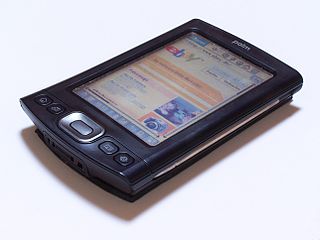
A personal digital assistant (PDA) is a multi-purpose mobile device which functions as a personal information manager. Following a boom in the 1990s and 2000s, PDA's were mostly displaced by the widespread adoption of more highly capable smartphones, in particular those based on iOS and Android in the late 2000's, and thus saw a rapid decline.

A Pocket PC is a class of personal digital assistant (PDA) that runs the Windows Mobile or Windows Embedded Compact operating system that has some of the abilities of modern desktop PCs. The name was introduced by Microsoft in 2000 as a rebranding of the Palm-size PC category. Some of these devices also had integrated phone and data capabilities, which were called Pocket PC Phone Edition. Windows "Smartphone" is another Windows CE based platform for non-touch flip phones or dumber phones.

A memory card is an electronic data storage device used for storing digital information, typically using flash memory. These are commonly used in digital portable electronic devices, such as digital cameras as well as in many early games consoles such as the Nintendo Wii. They allow adding memory to such devices using a card in a socket instead of protruding USB flash drives.
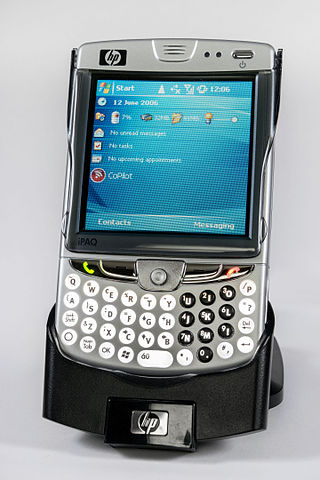
The iPAQ is a discontinued Pocket PC and personal digital assistant which was first unveiled by Compaq in April 2000.

The Sharp Zaurus is the name of a series of personal digital assistants (PDAs) made by Sharp Corporation. The Zaurus was the most popular PDA during the 1990s in Japan and was based on a proprietary operating system. The first Sharp PDA to use the Linux operating system was the SL-5000D, running the Qtopia-based Embedix Plus. The Linux Documentation Project considers the Zaurus series to be "true Linux PDAs" because their manufacturers install Linux-based operating systems on them by default. The name derives from the common suffix applied to the names of dinosaurs.
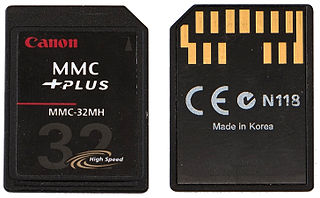
MultiMediaCard, officially abbreviated as MMC, is a memory card standard used for solid-state storage. Unveiled in 1997 by SanDisk and Siemens, MMC is based on a surface-contact low-pin-count serial interface using a single memory stack substrate assembly, and is therefore much smaller than earlier systems based on high-pin-count parallel interfaces using traditional surface-mount assembly such as CompactFlash. Both products were initially introduced using SanDisk NOR-based flash technology.
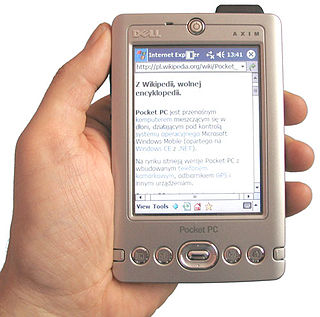
The Dell Axim family of personal digital assistants was Dell's line of Windows Mobile-powered Pocket PC Devices. The first model, the Axim X5, was introduced in 2002, while the final model, the Axim X51, was discontinued on April 9, 2007.
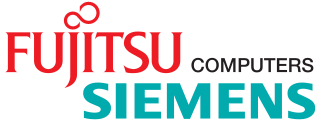
Fujitsu Siemens Computers GmbH was a Japanese and German vendor of information technology. The company was founded in 1999 as a 50/50 joint venture between Fujitsu of Japan and Siemens AG of Germany. On April 1, 2009, the company became Fujitsu Technology Solutions as a result of Fujitsu buying out Siemens' share of the company.
The Siemens SX45 is a PDA mobile phone released by Siemens in 2002. It was one of the first Pocket PCs with mobile phone functionality. Because of its size and the fact that phone calls could only be made using a headset, it was not really in the same marketing segment as current smartphones.

The Jornada was a line of personal digital assistants or PDAs manufactured by Hewlett-Packard. The Jornada was a broad product line that included Palm-Size PCs, Handheld PCs, and Pocket PCs. The first model was the 820, released in 1998, and the last was the 928 model in 2002 when Compaq and HP merged. The Jornada line was then succeeded by the more popular iPAQ model PDAs. All Jornada models ran Microsoft Operating Systems that were based on Windows CE.
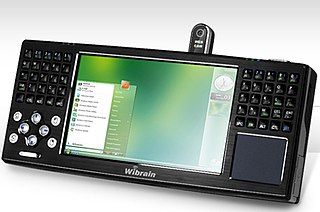
An ultra-mobile PC, or ultra-mobile personal computer (UMPC), is a miniature version of a pen computer, a class of laptop whose specifications were launched by Microsoft and Intel in Spring 2006. Sony had already made a first attempt in this direction in 2004 with its Vaio U series, which was only sold in Asia. UMPCs are generally smaller than subnotebooks, have a TFT display measuring (diagonally) about 12.7 to 17.8 centimetres, are operated like tablet PCs using a touchscreen or a stylus, and can also have a physical keyboard. There is no clear boundary between subnotebooks and ultra-mobile PCs, but UMPCs commonly have major features not found in the common clamshell laptop design, such as small keys on either side of the screen, or a slide-out keyboard.

The Samsung Q1 was a family of ultra-mobile PCs produced by Samsung Electronics starting in 2007. They had a 7" (18 cm) LCD and were made in several different versions with either Windows XP Tablet PC Edition or Windows Vista Home Premium.

The HTC Universal is a Windows Mobile 5.0 Pocket PC PDA manufactured by High Tech Computer Corporation. It was the first 3G/UMTS-enabled Pocket PC PDA with a telecommunications function, and also the first to come with Windows Mobile 5.0 pre-installed.
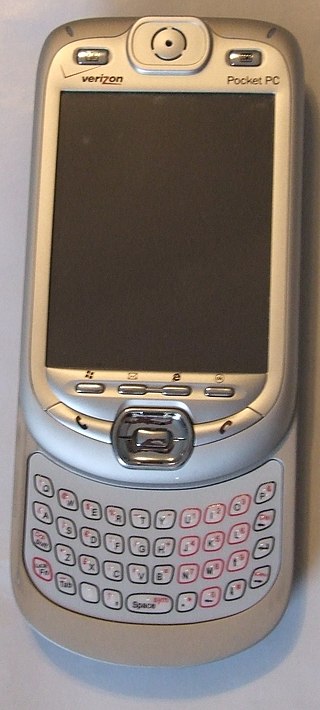
The HTC Blue Angel is a GSM Windows Mobile 2003 Second Edition PDA-phone, manufactured by High Tech Computer Corporation introduced in 2004. It has a CDMA EVDO variant called the HTC Harrier, which does not have Wi-Fi like the Blue Angel does. Both have the same housing. It is sold by many different vendors under the names of O2 XDA IIs, Orange SPV M2000, Dopod 700, Qtek 9090, T-Mobile MDA III, Siemens SX66, i-mate PDA2k, Vodafone VPx, Verizon XV6600 (Harrier), Sprint PPC-6601 (Harrier) among others, which all have similar hardware specifications.

The 560 series was the third and last series of Hewlett-Packard's Pocket PC format Jornada devices. It debuted in October 2001.

The BeagleBoard is a low-power open-source single-board computer produced by Texas Instruments in association with Digi-Key and Newark element14. The BeagleBoard was also designed with open source software development in mind, and as a way of demonstrating the Texas Instrument's OMAP3530 system-on-a-chip. The board was developed by a small team of engineers as an educational board that could be used in colleges around the world to teach open source hardware and software capabilities. It is also sold to the public under the Creative Commons share-alike license. The board was designed using Cadence OrCAD for schematics and Cadence Allegro for PCB manufacturing; no simulation software was used.

Fujitsu Technology Solutions GmbH is a Munich-based information technology vendor in the so-called "EMEIA" markets: Europe, the Middle East, India and Africa. A subsidiary of Fujitsu in Tokyo, FTS was founded in 2009 when the parent firm bought out Siemens' 50% share of Fujitsu Siemens Computers.
MilkyTracker is a free software multi-platform music tracker for composing music in the MOD and XM module file formats.

The Quest is a role-playing video game developed by Hungarian studio Redshift for PDAs in 2006. The game was ported to modern mobile devices three years later, and a remastered version was released in 2016. The remastered version added support for Microsoft Windows and macOS.